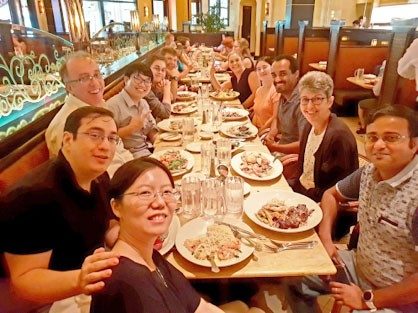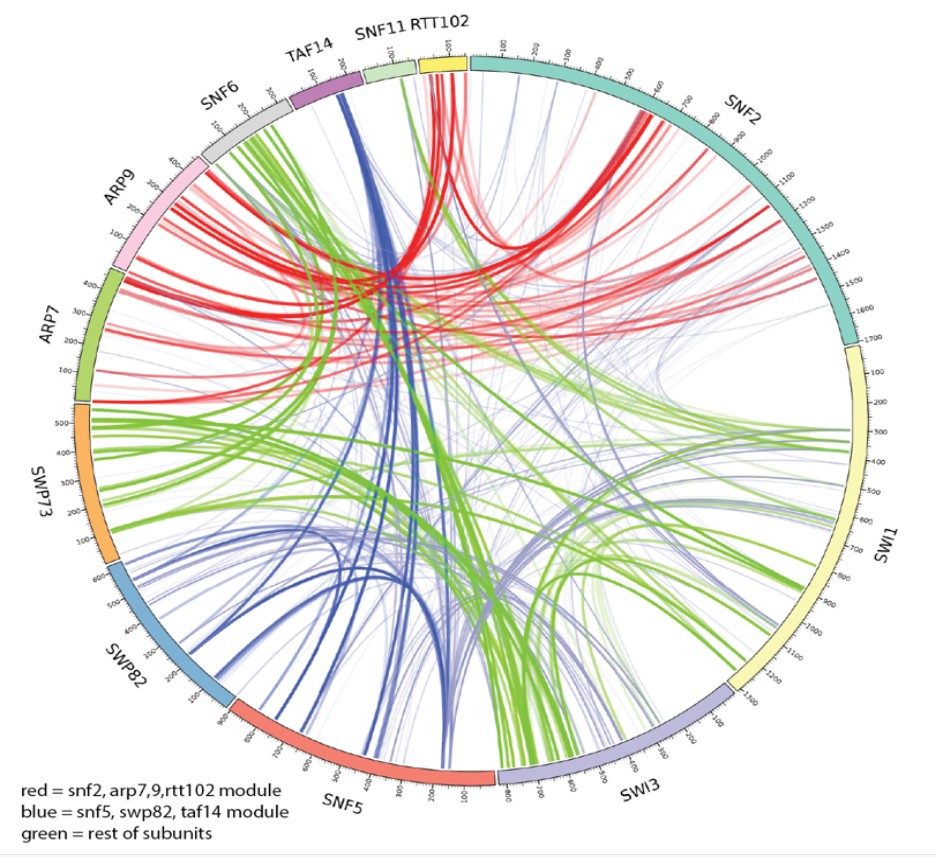Structure of INO80 bound to a nucleosome
Research

Welcome to the Bartholomew Lab!
The Bartholomew laboratory has developed techniques for probing protein-protein and protein-DNA interactions to understand the architecture of chromatin remodeling complexes, how they interact with nucleosomes, and the structural changes associated with chromatin remodeling. The lab has exploited this information to dissect the functional roles of different domains and subunits in nucleosome remodeling complexes using targeted mutagenesis combined with both state-of-the-art next-generation sequencing approaches and detailed biochemical assays. The lab's primary focus is on how these remodelers shape chromatin structure at promoter and enhancer regions and how they regulate the formation of preinitiation transcription complexes, release of paused RNA polymerase, and the direction of transcription. In addition, the lab is defining the roles of ATP-dependent chromatin remodelers in nuclear organization and long-range chromatin interactions using chromatin capture-based approaches coupled with other techniques to physically map these interactions.
The Problem
The recent rise of the field of epigenetics has revealed that organismal development, cellular differentiation, and human disease depend not only on the DNA encoding individual genes, but also on how DNA is packaged into chromatin and how access to packaged DNA is regulated. One key class of epigenetic regulators is ATP-dependent chromatin remodelers. This class comprises a large number of protein complexes that use the energy derived from ATP hydrolysis to remodel and/or reconfigure chromatin. These protein complexes vary in size from ~300 KDa to >1 MDa and belong to four major families: SWI/SNF, ISWI, CHD, and INO80. The challenge has been to define the similarities and differences between these complexes regarding how they reorganize chromatin and how they are recruited to different genomic sites. While we have learned some of the basic mechanisms related to these complexes, we have only begun to understand how individual proteins operate within the complexes and how mutations in these complexes lead to cancer and other diseases.
PyMOL-created movie showing the structure of the INO80 complex bound to a nucleosome, based on cryo-electron microscopy. Nucleosomal DNA is in beige, histone proteins in red, purple, yellow and red, and INO80 subunits Ino80, Arp5, Ies6, Ies2, Rvb1, Rvb2 in magenta, orange, aqua, green, light blue, and dark blue, respectively.
The Approach

The Bartholomew laboratory takes a multi-pronged approach to answer questions revolving around ATP-dependent chromatin remodelers and their influence on development and disease. Lab members start by analyzing the structure and function of these large chromatin remodeling machines using model systems like the yeast Saccharomyces cerevisiae.
Yeast provides an ideal platform for detailed biochemical and structural analyses. Structure/function relationships are typically tested by mutating or deleting individual protein domains within a subunit of the larger complex or within one or more of its targets followed by examining the activity of these complexes both in vitro and in vivo.
The information gained from the yeast analyses is then tested in mammalian systems using mouse embryonic stem cells (mESCs) in both their naïve state and when differentiated into various cell types. The cells are analyzed using a combination of cutting-edge genomics and state-of-the art microscopy to assess the impact of mutations on cellular activity (e.g. transcription) and chromatin architecture (e.g. chromatin structure and composition, and overall nuclear organization). In addition, the Bartholomew lab frequently collaborates with experts who use specialized biophysical approaches such as single-molecule FRET and advanced mass spectrometry to probe structural dynamics and protein interaction networks.
Innovations and Discoveries
The mammalian SWI/SNF complex plays a vital role in early cell fate determination

On the way toward differentiating into different cell types, pluripotent stem cells undergo dramatic transcriptional changes. They must pass through a crucial step during which cell fate programs are initiated for cell fate determination, while the pluripotency machinery is simultaneously shut down.
The Bartholomew lab has recently discovered that the mammalian SWI/SNF complex is required during this key step in development to facilitate both activation of crucial development-related genes and repression of pieces of the pluripotency machinery. They have shown that SWI/SNF is needed to activate stage-specific enhancers by promoting the binding of both key transcription factors and various histone modifiers to these enhancer regions.
The lab is currently endeavoring to understand more deeply what occurs as cells continue their developmental progression toward mature neurons and how SWI/SNF is involved in this progression. (For more information see the bioRxiv preprint describing these findings.)
Modes of SWI/SNF recruitment, the role of RNA in recruitment, and potential role in nuclear condensates (i.e. architecture)

The Bartholmew lab has recently discovered an unusual mechanism, distinct from interactions with DNA-sequence specific transcription factors, involved in the genomic recruitment of SWI/SNF to its cell-type specific targets. Towards the N-terminus of the SWI/SNF catalytic subunit is a motif called an extended AT-hook (eAT-hook) that preferentially binds RNA. Deletion of the AT-hook causes loss of SWI/SNF binding at cell-type specific enhancers resulting in corresponding changes in transcription.
Now, the lab is working to assess the RNA binding properties of the AT-hook both in vitro and in vivo and to determine whether RNA functions in cis or trans to recruit SWI/SNF through the AT-hook. In addition, they have found a co-dependency between SWI/SNF and the Mediator complex with Mediator recruitment being adversely affected by AT-hook deletion. These data indicate SWI/SNF may have a major role in nuclear condensate formation as the Mediator complex is well-known as a key factor in condensate formation. (For more information see the bioRxiv preprint describing these findings)
Actin-related proteins (ARPs) in the INO80 complex serve as important sensors and regulators of nucleosome remodeling

INO80 is an ATP-dependent chromatin remodeler that not only moves nucleosomes on DNA but also exchanges histones out of nucleosomes, a process that is important for transcriptional regulation, DNA repair, and DNA replication. Nuclear actin and several actin-related proteins (ARP4, ARP5 and ARP8) are also present in the INO80 complex.
The Bartholomew laboratory discovered that ARP4, ARP8, and actin form a protein module that binds to extranucleosomal/linker DNA and positively regulates the nucleosome mobilizing activity of INO80 in a DNA length-dependent manner. Portions of ARP8 and ARP4 interact with DNA and actin whereas a portion of the catalytic subunit Ino80 serves as protein scaffold for these ARPs. They also discovered that ARP8 and ARP4 allosterically regulate the binding of ARP5 to the histone octamer, which is important for coupling ATPase activity to nucleosome movement. (For more information, see Brahma S, et al, 2018, Nat Commun.)
Nucleosome plasticity and the ISWI chromatin remodeler

Nucleosome plasticity and the ISWI chromatin remodeler
For years, the nucleosome has been thought to be a rigid body that remains unchanged except for DNA movement, such as that occurring during ATP-dependent chromatin remodeling. The Bartholomew laboratory has developed compelling evidence that the histone octamer core of the nucleosome is not rigid, but rather, is dynamic.
The lab discovered that significant distortions of the nucleosome core occur early during remodeling and when these distortions are restricted, no additional remodeling can occur. These studies, focused on yeast ISW2, employed a wide variety of experimental approaches, including targeted mutagenesis, trapping remodeling intermediates, and identifying when and how the histone octamer is distorted. (For more information, see Hada et al., 2019, Cell Rep. )
